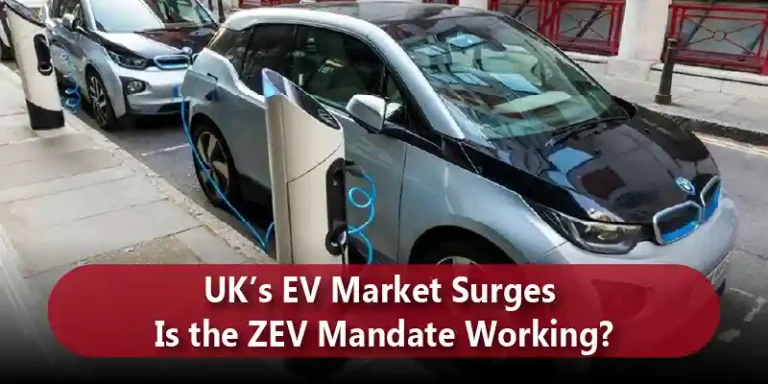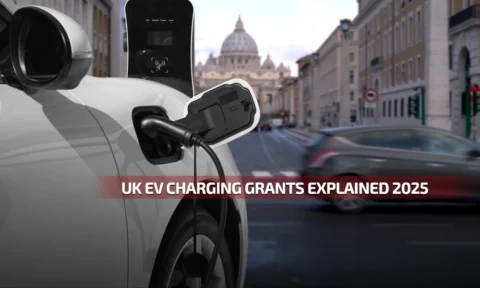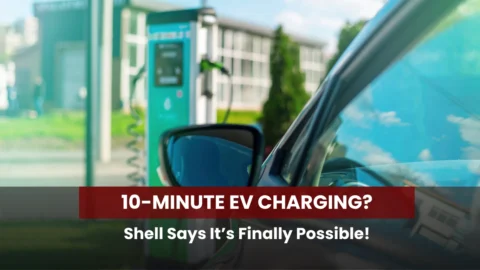The United Kingdom’s automotive landscape is undergoing a silent, yet seismic, transformation. New car showrooms, once dominated by the roar of petrol and diesel engines, are increasingly showcasing sleek, silent electric models. This rapid shift, backed by government policy, has led to a major surge in the UK electric car market.
But is this growth a natural, consumer-led phenomenon, or a regulatory consequence? The answer lies in one critical piece of UK EV policy 2025: the Zero Emission Vehicle (ZEV) mandate. This blog delves into the latest Electric vehicle statistics UK, dissects the mechanism of the mandate, and asks the crucial question: Is the ZEV mandate successfully accelerating the transition to zero-emission transport?
What is the ZEV Mandate UK, and Why Does it Matter?
The ZEV Mandate, which came into law in January 2024, is the single most important policy driving electric vehicle growth UK. It’s the UK’s roadmap for phasing out petrol and diesel cars.
The Surge: Electric Vehicle Sales UK in 2024-2025
The most compelling evidence of the mandate’s impact is found in the latest Electric vehicle statistics UK. The numbers show a market compelled to meet its obligations, especially in the car segment.
Record-Breaking Adoption
In 2024, carmakers sold a record number of electric cars in the UK, with new battery electric vehicles accounting for approximately 19.1% of all new car registrations, up from around 16% in 2023. This rapid growth continued into early 2025, with January 2025 marking a new high of 21.5% of all new-car registrations being fully electric.
While the 2024 final share of 19.1% was technically just below the 22% ZEV target, industry analysts suggest that when accounting for the mandate’s built-in flexibilities, most manufacturers were able to comply, thus avoiding large-scale fines.
The most telling sign of success is the consistent and ambitious climb, proving that a bold, well-executed strategy drives supply and growth.
Fleet vs. Private Buyers: Who is Driving the Charge?
A key statistic reveals where the mandate’s pressure is felt most acutely:
82% of new zero-emission vehicle registrations in 2024 were to company or fleet keepers.
Fleet operators who buy in bulk are highly responsive to the tax and compliance benefits of EVs, making them the primary target for manufacturers needing to meet their ZEV quotas. This push on the corporate side is having a ripple effect, creating a robust supply of high-quality, used EVs that will enter the private market in the coming years, directly addressing the barrier of upfront cost for more consumers.
Best Electric Cars UK: The Manufacturers’ Response
The ZEV mandate’s requirement for a growing percentage of sales to be zero-emission has directly influenced which cars are available in UK showrooms, leading to a much wider variety of models.
Leaders and Laggards
Manufacturers who committed early to electrification are now exceeding their targets and expanding their market share.
- The Leaders: Brands like Tesla are significantly exceeding targets. European manufacturers such as BMW and Mercedes-Benz 36.6% are leveraging their advanced EV lineups to push well past the 2025 minimum of 28%. This success shows that having attractive, readily available electric models is the key to both market growth and mandate compliance.
- The Laggards: Other legacy brands, like Nissan and Toyota, are struggling to meet the mandated pace. Their lower figures highlight the risk of being left behind as the market accelerates. However, the data also shows strong demand for their petrol models, meaning their risk of fines will force them to urgently divert more of their global EV stock to the UK electric car market.
Top-Selling Models
The demand for practical, long-range EVs is clear in the Best electric cars UK sales charts:
- Tesla Model Y: The UK’s best-selling EV in 2024, cementing its status as the all-rounder of choice, especially for the lucrative fleet market. The 2025 facelift further enhanced its ride quality and technology.
- Kia EV3: A highly anticipated, affordably priced, and family-friendly electric SUV with an impressive claimed range of up to 375 miles. It represents the growing focus on value and range outside of the premium segment.
- Skoda Elroq: Another new, practical electric SUV, designed to be an accessible, city-friendly version of the larger Enyaq.
The new launches for 2025 and 2026, many of which are in the popular SUV and crossover segment, are a direct result of the pressure from the ZEV mandate to fill market gaps and satisfy consumer demand for varied body styles.
The Roadblocks: Challenges for the ZEV Mandate
While the UK electric car market is surging, the ZEV mandate’s success is not without significant challenges, which need urgent attention under the broader UK electric vehicle regulations.
1. The Van Problem: Lagging Behind
The electric vehicle growth UK story is currently skewed towards cars. The ZEV target for vans in 2025 is 16%, but the market is lagging far behind. Challenges cited by fleet operators include a lack of availability of fit-for-purpose electric light commercial vehicles, especially specialised vehicles like tippers or dropsides that require significant payload capacity. The current shortfall suggests the van market will struggle to meet the rapidly increasing target of 46% by 2028.
2. Infrastructure and Affordability Concerns
The “two-tier system” remains a critical concern.
- Public Charging: While the network is expanding, the reliability, accessibility, and cost disparity remain friction points. Public charging often attracts a 20% VAT rate, compared to 5% for domestic charging, creating a “political timebomb” that penalises drivers without off-street parking.
- Upfront Cost: Despite lower running costs, the initial purchase price of an EV remains higher than a petrol equivalent. The removal of key purchase grants for cars, combined with new policies like the introduction of Vehicle Excise Duty (VED) for EVs in 2025, has worried industry groups who advocate for continued fiscal support to drive private demand.
3. Policy Instability
The ZEV Mandate, though a strong framework, has faced pressure and tweaks that have created uncertainty. Industry leaders emphasise that policy stability is business-critical; any sudden changes risk undermining the billions of pounds of investment already committed to charging infrastructure and battery production in the UK.
Is the Zero Emission Vehicle Mandate Working?
Yes, the Zero Emission Vehicle mandate UK is successfully delivering its primary objective: forcing the supply of EVs into the UK electric car market. The surge in registrations, the competitive push by manufacturers, and the influx of new electric models are all direct, measurable outcomes of the mandate’s aggressive yet predictable targets. It has transformed the UK from a market merely responding to consumer interest into one that manufacturers must prioritise globally.
The future of the UK electric car market hinges on the government’s resolve to hold course on the UK electric vehicle regulations and invest in the ‘carrot’ of infrastructure alongside the ‘stick’ of the mandate. The electric vehicle growth UK is on track, but the next few years will define whether this transition is successful for everyone, not just for company car drivers.
Most Common Inquiries
Manufacturers must ensure that 28% of the new cars they sell in the UK electric car market in 2025 are Zero Emission Vehicles. This minimum percentage will rise sharply to 80% by 2030 and reach 100% by 2035, as part of the wider UK zero-emission car targets.
The ZEV mandate UK has directly increased electric vehicle sales UK by creating an artificial supply pressure. Manufacturers, facing fines for non-compliant cars, are diverting more of their global electric stock to the UK to meet the minimum percentage requirements, leading to greater model availability and increased competition.
Current leaders in the Best electric cars UK segment for private buyers often balance range, price, and practicality. Popular models include the Tesla Model, the newly introduced, more affordable Kia EV3 for its long range and value, and practical SUVs like the Skoda Enyvoq and Volvo EX30.
The two main challenges for electric vehicle growth UK are the slow pace of van electrification, where the 2025 ZEV target for vans is proving difficult to meet, and the need for better, more reliable, and fairer public charging infrastructure to support drivers who cannot charge at home.
The ZEV mandate UK is the annual target that forces sales, while the official ‘ban’ is the final date by which all new cars sold must be ZEVs. The government’s current UK electric vehicle regulations set the final phase-out date for new non-ZEV cars at 2035.
For more hacks on getting the most range out of your EV, or car tips for making a switch to electric simple & join the conversation at Ask about cars.
For More Related Blogs:
From EVs to Supercars: What’s New on London Roads This Month
Driving an EV in the UK? These Apps Make Route Planning & Charging Easy
Battery Cost Recovery: Will It Slow Down Wales’ Electric Transition in 2026?
BEVs Hit 25% of October Sales: Is the UK Finally Reaching Mass EV Adoption?







